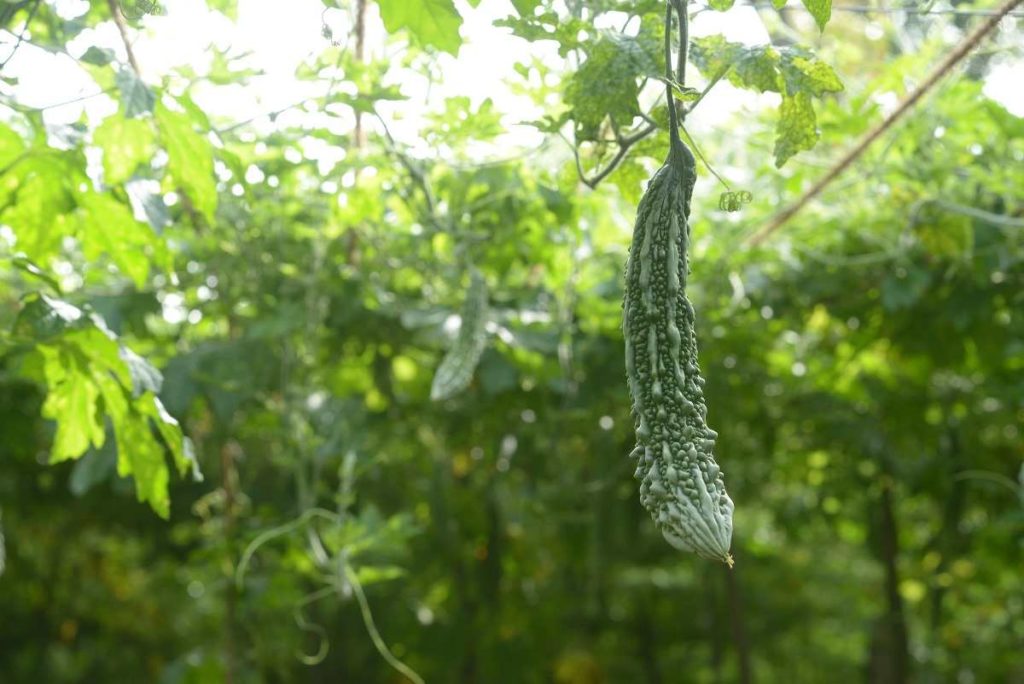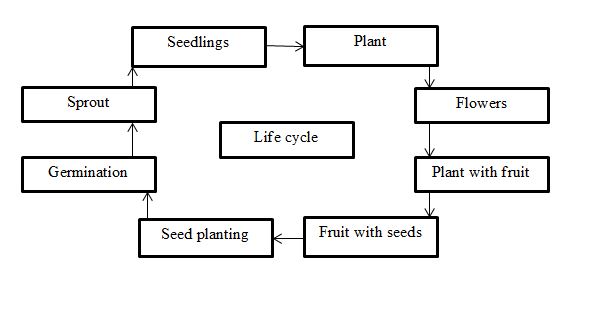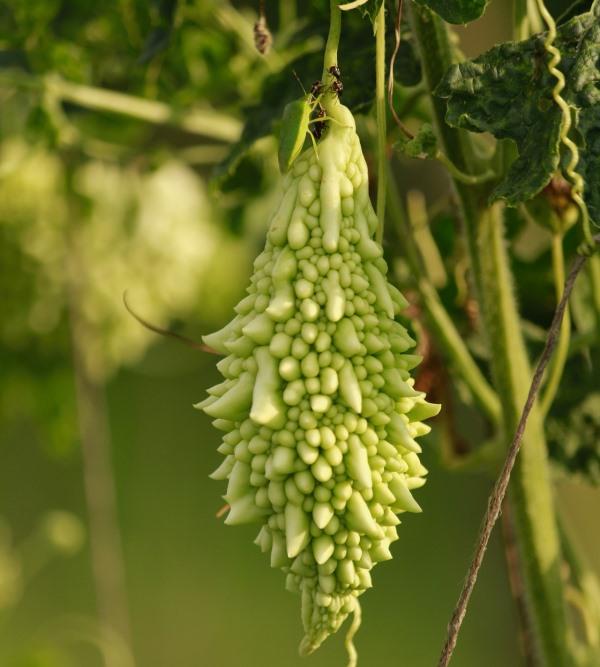Bitter Gourd Growing Tips, Techniques, Tricks, Ideas, and Secrets
Hello gardeners, we are back with a new and helpful topic today and the topic is all about bitter melon or bitter gourd growing tips, techniques, ideas, and secrets. Do you want to know all the basic and important growing tips while growing bitter gourd? Well and then you will need to follow this complete article to know all the tips and secrets for growing bitter gourd.
Introduction to Bitter Gourd
It is a tropical and subtropical vine and it belongs to the Cucurbitaceae family, widely grown in Asia, Africa, and therefore the Caribbean for its produce. Its many sorts differ substantially within the shape and even bitterness of the fruit.
Bitter Melon or Bitter Gourd is one of the foremost popular vegetables grown in South-East Asia. Other vegetables like cucumber, melon, or even pumpkin, also belong to the Cucurbitaceae. A native of the Indian subcontinent, it’s utilized in Asian delicacies. It is one of the healthiest vegetables and it has many medicinal uses. it’s a uniquely bitter and crunchy taste.
A Guide to Bitter Gourd Growing Tips, Tricks, Techniques, Ideas, and Secrets

Bitter melons are—as their name suggests it is a bitter and even mouth-puckering preference —something just like the acquired taste of grapefruit or very bittersweet chocolate.
The bitter melon may be a member of the Cucurbitaceae family, which incorporates squash, watermelon, muskmelon, and cucumbers. Bitter melon is often grown very similar to cucumbers or cantaloupes but they’re a subtropical plant and need a minimum of three to four months of considering hot and humid weather to mature.
Life Cycle of Bitter Gourd is Given Below

Soil Preparation Ideas for Growing Bitter Gourd
Bitter gourd usually survives very well in sandy and loamy soil rich in organic matter. Bitter gourd prefers slightly acidic to slightly alkaline soil. The pH range of soil needs to be around 6 to 7.1. Rather than gardening soil, use a billboard potting mix.
Add compost or manure to well-drained soil. Mix in organic materials to feature nutrients in the soil before you plant your seeds. Bitter melon prefers soft, sandy soil, so mix within the sand if you would like to.
Tips for Providing Support for Bitter Gourd
Build a trellis for the vines to climb. Confirm the trellis is a minimum of 6 feet or 1.8 m tall therefore the vines have room to grow and wrap around it. You need to shape the trellis-like the letter “A” over the complete growing area. Growing on a trellis will easily help to prevent diseases, make harvesting easier, and produce larger fruit.
Bitter melon that’s grown directly on the bottom won’t produce fruit as large as a trellised plant.
If you are doing not trellis your melons, add a layer of straw or mulch to make a barrier between the plant and therefore the soil, keep the moisture within the soil, and stop fruit rot.
You may also check this: How To Grow Organic Leafy Vegetables.
Bitter Gourd Propagation Tips
- Remove the Coating round the Seeds
Bitter gourd seeds tend to possess a red coating wrapped around them. This coating can be twiddling my thumb’s germination because it keeps water from entering the seed. Therefore the primary step is to chip away at a number of the coatings.
- Soak the Seeds
While bitter gourd seeds are often planted straight into compost, many gardeners find better results from first soaking the seeds overnight. This “kick starts” the germination process, just by allowing the seeds to right away absorb large volumes of water. Once planted in soil, such seeds tend to urge off to a far better start.
- Plant in a Pot
Bitter gourd seeds are good and best started indoors in a pot of sandy, well-drained compost. Once germinated, the plants grow rapidly, so attempt to choose a rather more generous pot than you would possibly for other plants otherwise you risk having to repot them continually.
Plant the seeds roughly 1cm deep within the compost. Water the pot thoroughly, while simultaneously avoiding soggy, waterlogged conditions which may stunt growth. When it involves bitter gourds, excellent drainage is significant.
- Transplant to a special Pot or Your Garden
After a couple of weeks, you ought to start to ascertain the seeds slowly start to sprout. They will initially take a while to become established, so patience in these first few weeks is vital. Because the plant develops, therefore the rate of growth will accelerate.
As your bitter gourd seeds mature into a young plant, you’ll then transplant them to a bigger pot or into your garden. Like all gourds, these are often thirsty, hungry, sun-loving plants, so aim to plant them in well-drained soil where they will enjoy much sunshine.
Ideas for Growing Bitter Gourd on Terrace
1. You need to find a warm sunny spot on your terrace.
2. Better to use organically rich, sandy, or loamy well-drained soil. A mix of trash and even compost also will do wonders for the plant.
3. You will use the bitter gourd seeds from any ripe bitter gourd you picked up from any vegetable market. Just confirm to use only the seeds that are fully formed. You’ll also use seeds from a previous plant, or buy them from your local nursery. If there’s a red coating on the seeds, remove them. If necessary, you’ll soak the seeds overnight in water before sowing to hurry up germination.
4. Make holes about half-inch deep within the soil and drop the seeds into them. You’ll leave about 12 inches of space between two holes. Better to cover the holes with soil and sprinkle some water on top. Sow a minimum of 2 seeds in a pot and use a minimum of 2 pots for sowing the seeds.
The seeds will start to germinate within 2 to 3 days of sowing and flowers will start to seem in 5-6 weeks. The gourds are going to be ready for selection within 3 months from planting.
Techniques for Growing Bitter Gourd
In case if you miss this: How To Grow Rose Flowers In Greenhouse.

1. Allow the soil to dry out before watering the seeds to stop them from rotting. You’ll still regularly water the plant to stay the soil moist, but not soggy.
2. Provide a support structure or trellis about 6 to 8 feet tall for the plant to hop on.
3. Pruning is extremely important to urge the utmost yield from the plant. 3 to 4 weeks after sprouting, the plant will start to develop lateral shoots. Stop the growing tips of the branches once they are about 2 to 3 feet long. The plant will then start producing side branches and even yield more flowers and fruits at a quicker pace.
4. If your bitter gourd plant features a lot of flowers but no fruits, it’s going to be because pollination isn’t happening on your terrace. You’ll encourage bees to go to your garden by planting a spread of flowering plants. But if you don’t have any flowering plants, then you’ll need to do the pollination yourself, manually.
You can do that by learning a male flower and gently rubbing it face to face with a female flower (identified by the presence of a fat module that’s shaped sort of a mini bitter gourd between the flower and therefore the vine stem). Otherwise, you could use a soft brush to softly wipe over the male flower then proceed to brush the feminine flower.
5. For every 3 weeks add liquid fertilizer or even seaweed solution to the soil.
6. If you would like bitter gourd seeds to sow for subsequent seasons, allow one gourd to ripen within the vine. It’ll turn yellow and once you cut open the fruit, it’ll reveal seeds with a gloriously red coat. Wash and dry the seeds in a shady place and then store them in an air-tight bag for re-use later.
Bitter Gourd Planting Tips
Soak the seeds for twenty-four hours before planting. Put the seeds in a bowl of water and allow them to soak for each day. This helps the seeds germinate quickly once they’re planted. After they need soaked, pat them dry with a towel.
Purchase bitter melon seeds from your local nursery or online.
Plant 2 to three seeds within the same hole 1⁄2 in or 13 mm deep within the soil. Plant the bitter melon directly outside. Poke a hole within the soil together with your finger and drop the seeds inside. Cover the opening with topsoil. If you propose to plant quite 1 bitter melon plant, space the holes 40 to 60 inches or 100 to 150 cm apart directly into the soil in your garden.
Seeds also can be planted in small pots crammed with a potting mix if temperatures outside aren’t ideal. Seedlings are often transplanted after 15 to 20 days once they’re planted in pots.
Watering Tips for Growing Bitter Gourds
Water the soil until the highest 1⁄2 in or 13 mm is damp. Use a watering pot to softly wet the soil. Put your finger into the soil right down to the primary knuckle. The soil needs to feel moist, but not completely waterlogged.
Continue to water the soil every morning. Water at an equivalent time a day so you are doing not forget. You ought to start to ascertain the seedlings germinating after 2 to 3 days. Confirm the soil is moist, but not completely wet.
Water the soil daily. Water the soil so that it’s moist 1⁄2 inch or 13 mm below the surface. Overwatering the soil could damage the basic system of your plant and cause the fruit to rot.
Use an home drip irrigation system to supply a uniform water source for your melons.
Bitter Gourd Fertilizing Ideas
Fertilize with a balanced NPK formula throughout the season. You need to only apply fertilizer after the plant has 4 to six true leaves. A store-bought fertilizer meant for fruit and a vegetable works well for bitter melon. Follow the directions on the label so you are doing not oversaturate the soil.
Water the soil immediately after you apply fertilizer so it’s an opportunity to soak into the roots of your plant.
Spray your bitter melon with fungicides to stop the disease. Bitter melon is vulnerable to equivalent diseases that affect cucumbers and squash. Use a fungicide made for squash from your local garden store to stop infections in your bitter melon.
Common diseases your bitter melon may encounter are watermelon mosaic pot virus, false mildew, or leaf spot. Search for splotchy discoloration on the leaves of your plant.
Fungal infections typically occur after long wet periods. Watch your plant carefully if there has been tons of rain in your area.
Apply an insecticide to stop insect infestation. Cucumber beetles are a standard pest and carry bacteria that will permanently damage the vines of your plant. Apply a pesticide with rotenone at dusk so you should not harm pollinators during the day. Better to follow the directions on the packaging so you don’t harm your plants.
Fruit flies could lay eggs within the fruit. If you notice any fruit flies near your plant, then protect individual fruit by wrapping them in newspapers or paper bags.
You need to only use harsh chemicals if the infestation causes significant damage to your plant.
If you’re getting to eat your bitter melon, stick with pesticides that are safe for human consumption, like soap sprays, vinegar, or Bacillus Thuringiensis (Bt).
Bitter Gourd Pruning Techniques
Prune the tip of the most stem once it grows past the highest of the trellis. Use a pair of shear to chop the growing stem back by 2 inches or 5.1 cm. This helps promote faster growth of fruit and puts the plant’s energy into the lateral vines that have grown from the most stem.
If you’re not growing on a trellis, prune the growing vine once the primary female flowers appear on the plant. Usually, female flowers will have knobby green stems attached to yellow petals.
Bitter Gourd Pest and Diseases Controlling Tips
- Western striped cucumber beetle
You need to monitor new planting regularly for signs of beetle and then apply appropriate insecticides.
- Squash vine borer
It is better to apply appropriate insecticide if eggs are found on leaves and plow plants into the soil after harvest.
- Phytophthora fruit and crown rot
You should not plant in poorly draining soils and better avoid over-watering plants. Also, rotate cucurbits with non-susceptible plants for at least 3 years.
- Watermelon mosaic
Treatments that control populations of aphid vectors can also reduce the incidence of the virus and spraying plants with mineral oils or insecticidal soaps can also help to reduce aphid numbers.
- Squash mosaic
It is better to use only certified disease-free seeds while planting.
- Cucumber mosaic
Control of the virus is largely dependent on the control of the aphid vectors and reflective mulches can deter aphid feeding; aphid outbreaks can be easily treated with mineral oils or even insecticidal soap applications; some resistant varieties are also available.
- Aster yellows
You need to remove any infected plants from the field to reduce spread and control weeds in and around the field that may act as a reservoir for the phytoplasma; you can also protect plants from leaf hopper vectors with row covers.
- Bacterial leaf spot
Better to avoid overhead irrigation and then rotate plants away from cucurbit species to prevent disease building up; you need to use new seed each planting as the saved seed is more likely to carry bacteria and then apply appropriate protective fungicides and copper-containing fungicides generally provide good control.
- Angular leaf spot
You need to use disease-free seed and should not grow plants in a field where cucurbits have been grown in the previous 2 years and use protective copper spray may help reduce the incidence of disease in warm, humid climates and also use plant resistant varieties.
- Verticillium wilt
You should not plant in areas where other susceptible plants have been grown previously and delay planting until temperatures are very warm.
- Scab
Better to rotate cucurbits with non-susceptible plants for at least 2 years and then plant only in well-draining soils. Also, spray plants with appropriate protective fungicides.
- Powdery mildew
You need to plant in sites with good air circulation and sun exposure and you should not overcrowd plants and also sanitize equipment regularly.
- Gummy stem blight
Better to use disease-free seed; treat seeds before planting and then rotate plants every 2 years.
- Downy mildew
Should not overcrowd plants and you need to avoid overhead irrigation, water plants from the base; also apply an appropriate fungicide.
- Cercospora leaf spot
Any diseased plants need to be removed and then destroyed to prevent further spread; plant debris should be removed after harvest or plowed deeply into the soil to reduce inoculum
- Anthracnose
Use plant-resistant varieties; use only certified seed and then apply appropriate protective fungicides; rotate plants every year.
Bitter Gourd Harvesting Tips
Better to pick fruits 12 to 16 weeks after planting when they are still very green. Use a pair of scissors to chop the hanging fruit from the vine. The fruit should be around 4 to six inches (10 to fifteen cm) long and firm to the touch once they are harvested. They’ll appear light green, but they’ll have yellow streaks on the flesh.
Plants that are completely yellow and even soft to the touch are overripe.
The fruit’s bitterness may vary, even when it’s grown on an equivalent vine.
You need to harvest every 2 days after the fruit starts to ripen. More fruit will form from an equivalent vine after you remove the fruit that’s already grown. Check your vines every other day to ascertain if you’ve got fruit able to be hampered. Fruits should be harvested before they fully ripen.
- How to Grow Tomatoes Organically at Home: A Comprehensive Guide
- Organic Gardening on a Budget: Low-Cost Methods and Materials
- Gongura Seed Germination and Planting Methods
- Cabbage Seed Germination and Selection
- Broccoli Seed Germination and Selection
- Asparagus Seed Germination and Variety Selection
- Seasonal Flower Gardening: Best Practices for Spring, Summer, Fall, and Winter
- How to Grow Hibiscus from Flower
- Plantation Ideas for Home Decoration: A Beginners Guide
- Flower Garden Designs and Layouts for Beginners
- Planting and Spacing Techniques in Papaya: A Beginner’s Guide
- Growing Gold: Essential Techniques for Planting Pineapples
- How to Make Kalanchoe Plant Bushy: Home Remedies and Solutions
- 11 Reasons Why Your Gardenia is Not Blooming: Home Remedies and Solutions
- Eco Elegance: The Guide to Designing a Drought-Tolerant Landscape
- Gardening on a Slope: Strategies for Hillside Landscaping
- Nourish and Flourish: Top Organic Mulches for Thriving House Plants
- Everything You Want to Know about Indian Mogra Flower: Discover Uses and Growing
- Green Thumb Success: Expert Tips for Cultivating Greenhouse Pumpkins All Year Round
- Maximize Growth & Flavor: The Ultimate Guide to Companion Planting in Herb Gardens
- How to Control Rhododendron Problems Naturally: Home Remedies and Organic Ways to Fix Them
- Natural Magic: The Remarkable Benefits of Cinnamon for Plants
- Best Steps to Revive Dying Tulip with Natural and Organic Treatment
- 10 Reasons Why Your Angel Trumpet is Not Blooming: Remedies and Treatment